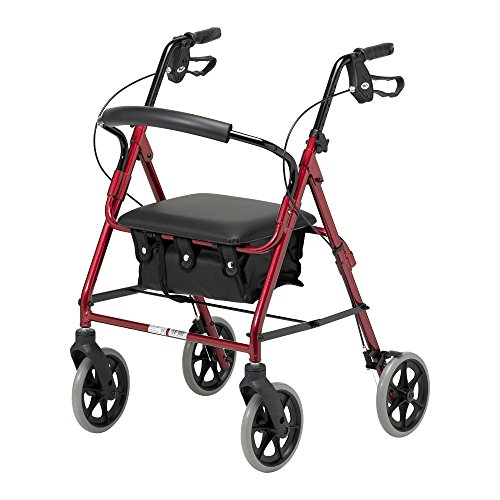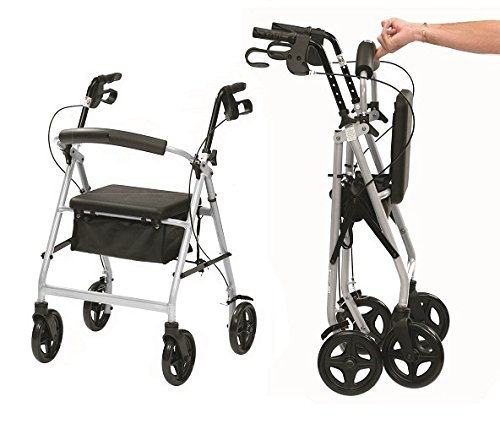15 Best Documentaries On Rollator Folding
페이지 정보
작성자 Minna 작성일24-07-16 00:14 조회56회 댓글0건관련링크
본문
 Locking Mechanism For Use With a Foldable Rollator
Locking Mechanism For Use With a Foldable RollatorMost rollators have some kind of locking mechanism or latch to prevent them from slamming during storage. This is crucial for security and to avoid a dangerous situation during transportation.
The lock is located in the middle of the frame. It can be a button or a lever. It is essential to understand how to use this feature.
How to Fold a Rollerator
Rollators are highly effective mobility aids for those who need support and stability when walking. They are lightweight and convenient and come in a variety of models available to meet different requirements and budgets. 1 However, some people may be concerned about how to fold and unfold a rollator and transport chair in order to safely use it.
Fortunately, the majority of modern walkers are built with easy-to-use folding mechanisms. They permit users to swiftly fold their walkers with no need for any tools, making them perfect for storage and transportation. The locking mechanism ensures that the walker won't fall open when it's being transported or stored and offers users safety and security.
Modern rollator walkers aren't only simple to fold, but also come with ergonomic designs that guarantee the user's safety and comfort. For example, they have comfortable handles, a large basket, and a brake lever that is built-in to avoid accidental activation. They are also made of lightweight materials for portability and easy handling.
The traditional rollators are heavier and don't support themselves while folded. This makes them difficult to transport or store. The seats are also fixed to the frame, which means that they can't be stored against objects or small spaces. Therefore, it is essential for people who have the rollator to understand how to fold their walkers for more convenient storage and transport.
The first step to fold a rollator involves finding the locking mechanism. It's usually in the middle of the frame. Once you find it and lift it gently, or release it according to the instructions provided by the manufacturer. Once the locking mechanism is removed, you can fold the walker by pushing its sides towards each and holding the releases. Continue doing this until the walker is completely folded and securely locked.
In addition to checking that the lock is secure and that the lock is secure, you should also check your walker for loose parts and indications of wear or damage. Repair any problems immediately to prevent further injuries or damage. In addition, it is recommended to lubricate regularly all moving parts of the walker to minimize friction and maintain smooth operation.
The Crossbar
The crossbar is the central bar that supports a rollator's frame and wheels. It is typically made of steel and connects the handlebars to the frame's base. The crossbar adds strength and stability and can also hold the basket of the walker and www.mymobilityscooters.Uk other accessories. Most manufacturers offer a variety of accessories that can be added to their walker models, which include baskets for storage and bags for totes. These can be attached on the front or the back of the walker, or placed underneath the seat.
A lot of walker models come with a crossbar that folds two directions, making them easier to carry and store. This is an important feature, especially if the walker will be often used for travel, or long journeys to the grocery store or other places. Some walker models also have a bag that can be removed that can be used as additional storage.
The brakes are a crucial element of a rolling walker. They are typically found on the crossbar and handles. There are a variety of brakes, including cable loops and push-down brakes. The push-down brakes require the user to provide downward pressure to the spring-loaded frame in order to stop the walker from sliding. This kind of system might not be well-suited for petite users who might struggle to engage the brakes, or heavier users who might unintentionally activate the brakes without knowing it.
The cable loop brake works similar to the brakes on a bicycle. It can be engaged by pressing the handlebars and levers at the same time using both hands. This type of brake system is suited to individuals who have limited hand movement, and offers more control than the push-down brakes.
The term "crossbar" is used to describe a single vertical stroke that connects two strokes in a letterform. The location, length, and thickness of a crossbar will affect the legibility of any letterform. This is a significant difference between serif and non-serif fonts. The crossbar of the small e for instance, is often described as an arm.
The Release Mechanisms
Rollators play a pivotal role in boosting mobility and empowering users facing physical challenges. This innovative stability helps distribute the user's weight evenly across their lower body, reducing strain to muscles and joints and allowing for effortless and comfortable movement. With features that can be customized, such as handbrakes and handlebars that can be adjusted, built-in seats, and storage compartments they make it much easier for users to navigate their environment with comfort and confidence. Additionally, these light and portable mobility aids are usually covered by Medicare or Medicaid to help with affordability.
As opposed to traditional walkers that have a basket and seat and need to be stored in the trunk of your car, carbon rollators fold down to allow for easy car transport or compact storage. To do this, remove the basket from the frame and then pull up the crossbar. This will reveal a pair of release mechanisms on each side. Then, press the release mechanisms, and push the sides of the frame until the walking device shrinks to its smaller size.
The locking assembly affixes to a top, substantially horizontal support arm 218 joining two vertically oriented tubular legs for the front and rear 220 and 222. Releasably connected to the ends of the front and rear tubular legs are telescoping tubular leg extensions 226 and 228, respectively. The telescoping extension is able to be rotated from an unlocked to an unlocked position to alter the height.
Once the extension leg segments are placed in the right place, a nonsliding handle is attached to the end of actuating lever. The actuating lever attaches to the housing by way of an extension portion that extends from the frame and a recessed portion dimensioned to accommodate the extension piece. The extension piece and recessive piece provide an angle around which the actuating lever can be swung.
Once the telescoping leg segments are in the appropriate position, the locking mechanism engages a snap button and biasing spring (not shown). This arrangement allows the user to easily engage or disengage the folding mechanisms, allowing for easy storage and transportation of the walking aid.
The Locking Mechanism
The present invention is an locking mechanism that can be used with foldable walkers or rollators. The invention addresses a need for a lock assembly suitable for use with these walkers and rollators that are easy to adjust between folded and unfolded positions by persons who may have limited dexterity.
In general, the device is comprised of two spaced side frames with an interlocking cross brace. It also comes with two handle bars. Two hand brakes have been fixated to the handles. Each has a pin-actuating plunger which engages with the plunger on the cross bar. When the user presses the hand brakes, the pin actuating plunger is released, causing the side frame to fold into a position.
This type of device comes with an issue in that the actuating handle needs to be held by one hand, while trying to press the plunger that is pin-actuated. This could be a challenge for people with weak hand strength and/or dexterity. The present invention resolves this issue by providing a locking assembly that is operatively connected to the actuating mechanism.
As shown in FIG. As shown in FIG. A lock plate is placed within the bore. It has an opening which can be used to receive the locking end of a locking pin. The portion of the actuating handle between the end of the handle that is force-applying and the attachment portion of the body is designed to pivot with respect to both body parts, such that the locking plate is moved from the initial position where it blocks rotation for the corresponding tubular leg to a second position in which the telescoping legs can be extended.

댓글목록
등록된 댓글이 없습니다.




